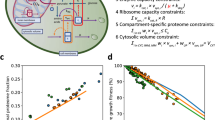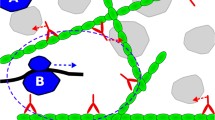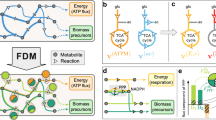Abstract
Cellular metabolites frequently have more than a single function in the cell. For example they may be sources of energy as well as building blocks for several macromolecules. The relative cellular needs for these different functions depend on environmental and intracellular factors. The intermediary products of phosphorylation of pyruvate by mitochondria, for example, are used for growth, while the released ATP is used for both growth and maintenance. Since maintenance has priority over growth, and maintenance is proportional to a cell’s mass, a cell’s need for ATP vs. building blocks depends on the growth rate, and hence on substrate availability. We show how the concept of Synthesising Units (SUs) in linear and cyclic pathways takes care of the correct variation of the ATP/building block ratio in the context of the Dynamic Energy Budget (DEB) theory. This can only be achieved by an interaction between subsequent SUs in transferring metabolites. Apart from this interaction we also needed an essential feature of the performance of the pathway in the DEB context: the relative amount of enzymes varies with the growth rate in a special way.We solved an important consistency problem between the DEB model at the whole-cell level and a model for pathway dynamics. We observe that alternative whole-cell models, such as the Marr-Pirt model, that keep the relative amount of enzymes constant, and hence independent of the growth rate, will have problems in explaining how pathways can meet cells’ growth-dependent needs for building blocks vs. ATP.
Similar content being viewed by others
References
Brandt, B.W., Kelpin, F.D.L., Leeuwen, I.M.M.v., Kooijman, S.A.L.M., 2003. Modelling microbial adaptation to changing availability of substrates. Water Res. 38, 1003–1013.
Droop, M.R., 1973. Some thoughts on nutrient limitation in algae. J. Phycol. 9, 264–272.
Heinrich, R., Rapoport, T.A., 1974. A linear steady-state treatment of enzymatic chains. General properties, control and effector strength. Eur. J. Biochem. 42, 89–95.
Heinrich, R., Schuster, S., 1996. The Regulation of Cellular Systems. Chapman & Hall, New York.
Hofmeyr, J.-H.S., 1989. Control-pattern analysis of metabolic pathways. Flux and concentration control in linear pathways. Eur. J. Biochem. 186, 343–354.
Hofmeyr, J.-H.S., Cornish-Bowden, A., 2000. Regulating the cellular economy of supply and demand. FEBS Lett. 476, 47–51.
Kacser, H., Burns, J.A., 1973. The control of flux. Symp. Soc. Exp. Biol. 27, 65–104.
Kooijman, S.A.L.M., 1998. The synthesising unit as model for the stoichiometric fusion and branching of metabolic fluxes. Biophys. Chem. 73, 179–188.
Kooijman, S.A.L.M., 2000. Dynamic Energy and Mass Budgets in Biological Systems. Cambridge University Press.
Kooijman, S.A.L.M., Auger, P., Poggiale, J.C., Kooi, B.W., 2003. Quantitative steps in symbiogenesis and the evolution of homeostasis. Biol. Rev. 78, 435–463.
Kooijman, S.A.L.M., Hengeveld, R., 2004. The symbiontic nature of metabolic evolution. In: Reydon, T.A.C., Hemerik, L. (Eds.), Current Themes in Thoeretical Biology: A Dutch Perspective. Springer, Dordrecht.
Lika, K., Nisbet, R.M., 1999. A dynamic energy budget model based on partitioning of net production. J. Math. Biol. 41, 361–386.
Lodish, H., Berk, A., Zipursky, S.L., Matsudaira, P., Baltimore, D., Darnell, J., 2000. Molecular Cell Biology. W.H. Freeman & Co, New York.
Painter, P.R., Marr, A.G., 1968. Mathematics of microbial populations. Annu. Rev. Microbiol. 22, 519–548.
Palsson, B.O., Palsson, H., Lightfoot, E.N., 1985. Mathematical modelling of dynamics and control in metabolic networks. III linear eaction sequences. J. Theor. Biol. 113, 231–259.
Pirt, S.J., 1965. The maintenance energy of bacteria in growing cultures. Proc. R. Soc. Lond. B Biol. Sci. 163, 224–231.
Savageau, M.A., 1976. Biochemical Systems Analysis. Addison-Wesley Publishing Company, Reading, MA.
Segel, L.A., 2001. Diffuse feedback from a diffuse informational network. In: Segel, L.A., Cohen, I. (Eds.), Design Principles for the Immune System and Other Distributed Autonomous Systems. Oxford University Press, pp. 203–226.
Author information
Authors and Affiliations
Corresponding author
Rights and permissions
About this article
Cite this article
Kooijman, S.A.L.M., Segel, L.A. How growth affects the fate of cellular metabolites. Bull. Math. Biol. 67, 57–77 (2005). https://doi.org/10.1016/j.bulm.2004.06.003
Received:
Accepted:
Issue Date:
DOI: https://doi.org/10.1016/j.bulm.2004.06.003




